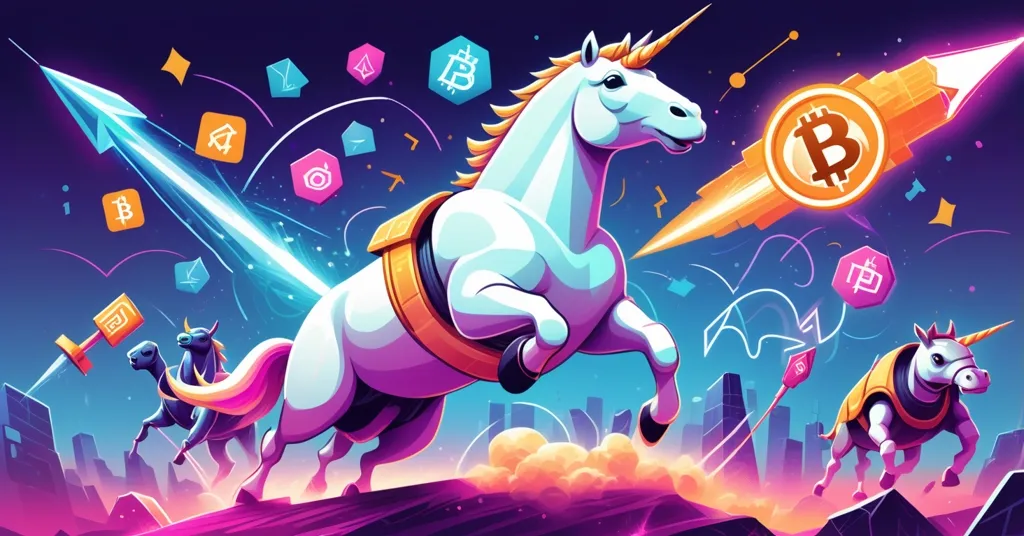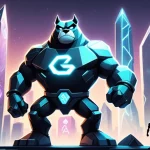BlockDAG Dev Boom, Uniswap Price Surge, and Tron Stability Shake Crypto Market

BlockDAG’s Developer Surge Sparks Hope, While Uniswap and Tron Chase Breakouts in Crypto Market
Three distinct players are making noise in the crypto sphere right now: Uniswap (UNI) with its promising price charts, Tron (TRX) holding firm with solid network stats, and BlockDAG (BDAG) turning heads with a massive developer community crafting real-world solutions. Each brings a unique angle to the table, but not without risks and unanswered questions. Let’s break it down with the cold, hard facts and a healthy dose of skepticism.
- Uniswap’s Bullish Signals: UNI’s chart suggests a potential jump to $12–$14 if key support levels hold.
- Tron’s Steady Grind: TRX stays stable above $0.31, backed by heavy transaction volumes and buyer activity.
- BlockDAG’s Bold Claims: With 4,500+ developers and a $353 million presale, BDAG pitches itself as a game-changer—proof pending.
Uniswap: A DeFi Giant Eyeing Recovery
Uniswap, a cornerstone of decentralized finance (DeFi) on the Ethereum blockchain, is flashing signs of a comeback. For the uninitiated, a decentralized exchange (DEX) like Uniswap lets users swap tokens directly from their wallets using smart contracts, cutting out middlemen like traditional exchanges. It’s like a self-service crypto kiosk—trustless and transparent, at least in theory. Since early data points in recent analysis, UNI’s price chart has formed what traders call a rounding bottom pattern, often a signal of a shift from bearish despair to bullish hope. A breakout above the $9.00–$9.20 resistance zone pushed prices to a high of $11.00, with the current level holding steady above the critical neckline. Short-term indicators add fuel to the fire: the 9-day Exponential Moving Average (EMA), a tool that smooths out price data over the last nine days to reveal trends, is trending up, and trade volumes are climbing, hinting at growing investor interest.
If this traction sticks, some market watchers are targeting $12 or even $14 as realistic next steps for UNI—a tidy gain from where it sits now. But let’s slam the brakes on the hype train. The crypto market can turn on a dime, and Uniswap isn’t immune to broader storms. Regulatory heat on DeFi protocols is a real threat, with bodies like the U.S. Securities and Exchange Commission (SEC) eyeballing platforms like Uniswap for potential securities violations. Past probes into Uniswap Labs serve as a stark reminder that no amount of bullish charting can shield a project from legal roadblocks. Beyond that, competition in the DeFi space is brutal—rivals like Curve and Balancer are nipping at Uniswap’s heels, vying for liquidity and users. While the UNI governance token, which lets holders vote on protocol changes and earn a slice of fees, adds value, it’s no guarantee of sustained growth. Short-term traders might ride this wave, but anyone playing the long game needs to watch the horizon for potential risks in DeFi price movements. Long-term players need to stay cautious, eyeing red flags, not just green candles.
Tron: Stability or Stagnation?
Tron, the blockchain brainchild of the polarizing Justin Sun since 2017, keeps chugging along with a stubborn kind of grit. Built to host decentralized applications (dApps) and enable cheap, fast transactions for content sharing, TRX has carved out a niche despite constant shade thrown its way for centralized control. Right now, its price hovers above $0.31, a beacon of stability in a sea of crypto chaos. Dig into the on-chain metrics for TRX, and you’ll see why: the Spot Taker Cumulative Volume Delta (CVD)—a metric that tracks whether buyers or sellers are dominating trades—shows a clear lean toward buyers over the past 90 days. That’s a fancy way of saying demand isn’t just a flash in the pan; it’s consistent.
Tron’s network stats are equally beefy. It’s pumping out over 28,500 blocks daily, and in a recent quarterly snapshot, it logged a staggering 780 million transactions. CryptoQuant analyst Maartunn has pointed to this “Taker Buy Dominant” trend as a possible prelude to price growth, tying it to increased network usage and ecosystem tweaks like stablecoin activity. Another analyst, CryptoOnchain, backs this up, spotlighting Tron’s steady block production and upgrades like the Dynamic Energy Model, which fine-tunes transaction costs, alongside staking yields as high as 7.31%.
Maartunn notes: “The sustained buyer dominance in Tron’s Spot Taker CVD over 90 days often precedes price upticks, reflecting genuine network activity and ecosystem growth.”
But let’s not sip the Kool-Aid just yet. High transaction numbers look great on paper, but are they meaningful? Some reports hint at declining usage for Tron’s dApps, suggesting a chunk of that activity could be bots, spam, or just inflated noise—think of it as a busy highway with no real destinations. Then there’s the elephant in the room: Tron’s governance feels more like a monarchy under Sun than a decentralized utopia. Bitcoin purists, myself included, can’t help but cringe at this setup—it’s the antithesis of what crypto should stand for. Add in Sun’s own controversies, from plagiarism accusations to SEC run-ins, and you’ve got a project that’s stable, sure, but possibly stagnant. For deeper insight into these concerns, check out discussions on Tron’s centralization issues. Compared to nimble competitors like Solana or even Binance Smart Chain, is Tron innovating or just surviving? That’s the million-dollar question.
BlockDAG: A Builder’s Dream or Hype Machine?
Now let’s shift gears to the dark horse of this lineup: BlockDAG. While Uniswap and Tron play the price and metrics game, BDAG is selling a vision of raw, organic growth. This project runs on a Directed Acyclic Graph (DAG) structure—a tech setup that’s less like Bitcoin’s linear blockchain and more like a sprawling flowchart, promising faster transactions and better scalability by handling multiple paths at once. It’s a potential answer to the crypto “trilemma” of balancing security, scalability, and decentralization. For a detailed breakdown, explore the technical explanation of BlockDAG’s blockchain. BlockDAG claims over 4,500 developers are actively coding on its network, hammering out more than 300 real-world projects across decentralized finance (DeFi), AI-driven tools, supply chain tracking, and digital identity systems. If legit, that’s a serious flex—not just another token, but a platform with roots taking hold.
The presale numbers are downright gaudy. Kicking off at a measly $0.001, the price has rocketed 2,660% to $0.0276 in its 29th batch, raking in over $353 million with 24.3 billion coins sold. Ahead of a hyped GLOBAL LAUNCH on August 11 (year unclear, which is a red flag in itself), BDAG is offered at $0.0016, teasing a potential 3,025% return for early investors. That’s the kind of carrot that gets FOMO-driven wallets itching to open. Curious about the buzz? Check out the community discussions on BlockDAG’s presale for varied perspectives.
As someone who cheers for disruption and effective accelerationism—pushing tech forward now, not later—I want to root for BlockDAG. A bustling developer ecosystem is exactly what crypto needs to move beyond speculation and into utility. For more on their claimed growth in areas like DeFi and AI, see this analysis of BlockDAG’s developer activity. But here’s where I put on my tin-foil hat: there’s zero hard proof to back these claims. No public GitHub repos, no on-chain activity trackers, no testnet stats—nothing to confirm 4,500 developers or 300 projects exist outside glossy marketing copy. In a space littered with vaporware and outright scams, extraordinary claims need extraordinary evidence. History is brutal on presale darlings; look at BitConnect or OneCoin, which promised the moon and left investors holding ashes. Without transparency, this smells like a shiny Ponzi scheme with extra steps. If you’re tempted by that 3,025% return, demand proof first—run, don’t walk, if they can’t provide it. Some skeptics have raised valid concerns, as seen in this discussion on BlockDAG presale risks.
Even if the numbers check out, let’s think bigger. A DAG-based blockchain could shake up the scalability debate, potentially powering real use cases like instant microtransactions for supply chains or secure digital IDs. But unproven tech is a gamble—Bitcoin’s battle-tested network didn’t get there overnight. BlockDAG’s vision is bold, but execution is everything, and right now, it’s all smoke until we see fire.
Counterpoints and Risks Across the Board
For Uniswap, the bullish chart is only half the story. DeFi’s future hinges on navigating a regulatory minefield—think Ripple’s ongoing SEC battle, but for DEXs. A crackdown could tank UNI’s momentum faster than any bearish reversal. Plus, Ethereum’s high gas fees, while improved since the Merge, still push users toward cheaper alternatives, challenging Uniswap’s dominance.
Tron’s stability masks deeper flaws. Centralization isn’t just a philosophical gripe; it’s a single point of failure. If Justin Sun’s empire faces legal or financial heat, TRX could crumble. And those transaction volumes? Without clear dApp adoption—say, thriving gaming or stablecoin platforms—they’re just hollow stats. Tron might be a workhorse, but it’s not winning any innovation races.
BlockDAG’s risks are the loudest. Presale hype is crypto’s oldest trap, often preying on hope over homework. If those developers and projects are real, show us the receipts—code commits, whitepapers, anything. Until then, it’s a gamble dressed as a goldmine. Even if legit, new tech like DAG carries teething pains; security glitches or failed adoption could doom it before it starts. For broader context on the momentum and challenges faced by these projects, take a look at this overview of BlockDAG’s growth alongside Uniswap and Tron.
What This Means for the Crypto Revolution
Zooming out, these three projects reflect the messy, vibrant state of crypto today. Uniswap embodies DeFi’s resilience, fighting to prove decentralized trading can outmuscle centralized giants. Tron grinds on as a high-throughput option, flawed but functional, filling gaps Bitcoin doesn’t touch. BlockDAG, if it delivers, could hint at the next wave of blockchain tech—scalable, practical, disruptive. Yet, as a Bitcoin maximalist at heart, I’ve got to say: none match BTC’s raw security or network effects. Bitcoin is the unshakeable core of this space, the ultimate middle finger to centralized control. Altcoins like UNI, TRX, and BDAG play vital roles in niche innovation—swaps, dApps, scalability—but they’re still sidekicks, not the main event. This diversity drives the financial uprising we’re all here for, just don’t bet the farm on unproven promises.
Key Questions and Takeaways for Crypto Enthusiasts
- What’s behind Uniswap’s potential price surge?
A rounding bottom pattern and breakout above $9.00–$9.20, with rising trade volumes, suggest targets of $12–$14, though regulatory risks and competition loom large. - How is Tron maintaining its market stability?
TRX holds above $0.31 with buyer-heavy on-chain data and 780 million quarterly transactions, but centralized control and questionable adoption raise doubts. - Why is BlockDAG generating so much buzz?
Claims of 4,500 developers and 300+ projects, plus a $353 million presale, paint it as a scalability contender, but unverified data screams caution. - Are presale gains like BlockDAG’s a smart investment?
Hardly—potential 3,025% returns are tempting, but without transparency, it’s a high-stakes bet with a history of catastrophic flops in crypto. - How do altcoins stack up against Bitcoin’s dominance?
Altcoins like UNI, TRX, and BDAG innovate in DeFi, dApps, and tech, but Bitcoin’s unmatched security and ethos remain the gold standard—diversity matters, skepticism more so.
Looking ahead, the trajectory of these projects could tell us plenty about crypto’s next chapter. Uniswap might solidify DeFi’s mainstream push if it dodges legal bullets. Tron could hold its ground as a low-cost utility player, or fade if innovation stalls. BlockDAG, if it proves itself, might pioneer a scalability breakthrough—or crash as another overhyped footnote. One thing’s certain: the road to disrupting the status quo is paved with both brilliance and broken dreams. Stay sharp, dig deep, and always question the narrative. That’s the only way to navigate this wild frontier.



